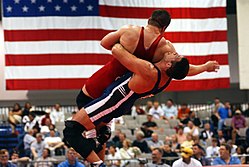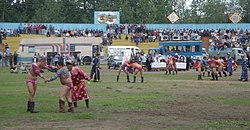Wrestling: Difference between revisions
m Reverted edits by Redhotsaxman (talk) to last version by Alexandru Stanoi |
Redhotsaxman (talk | contribs) |
||
| Line 292: | Line 292: | ||
{{commons cat|Women's wrestling|Women's Wrestling}} |
{{commons cat|Women's wrestling|Women's Wrestling}} |
||
*[http://www.fila-wrestling.com/ FILA Wrestling] |
*[http://www.fila-wrestling.com/ FILA Wrestling] |
||
*[http://www.britanniawrestling.co.uk/ British Wrestling] |
|||
{{Martial arts}} |
{{Martial arts}} |
||
Revision as of 21:54, 16 June 2009
 Ancient Greek wrestlers (Pankratiasts) | |
| Focus | Grappling |
|---|---|
| Olympic sport | Yes, Greco-Roman and Freestyle |
Wrestling is part of the martial arts. A wrestling match consists of physical engagement between two people in which each wrestler strives to get an advantage over, or control of, the opponent. Physical techniques used, include clinching, holding, locking, application of leverage and takedowns. Today there are a wide range of styles with varying rules.
Particular wrestling styles, have particular rules. Also, one can distinguish between traditional and non-traditional styles of wrestling, and wrestling techniques found in military hand-to-hand combat and self-defence systems.
Mythology

Some of the earliest references to wrestling, can be found in wrestling mythology.
- The Mahabharata describes the encounter between the accomplished wrestlers Bhima and Jarasandha.
- The Epic of Gilgamesh: Gilgamesh established his credibility as a leader, after wrestling Enkidu.
- Greek mythology celebrates the rise of Zeus as ruler of the earth after a wrestling match with his father, Cronus. Both Heracles and Theseus were famous for their wrestling against man and beast.
History
- Shuai Jiao, a wrestling style originating in China, has a reported history of over 4,000 years.
- In Egypt, wrestling has been evidenced by documentation on tombs (circa 2300 BC) and Egyptian artwork (2000-1085 BC).
- Greek wrestling was a popular form of martial art, at least in Ancient Greece (about 1100 to 146 BC).[1]
- Roman Wrestling: After the Roman conquest of the Greeks, Greek wrestling was absorbed by the Roman culture and became Roman Wrestling during the period of the Roman Empire (510 BC to AD 500).[citation needed]
- Arabic literature depicted Muhammad as a skilled wrestler, defeating a skeptic in a match at one point. By the eighth century, the Byzantine emperor Basil I, according to court historians, won in wrestling against a boastful wrestler from Bulgaria.[2]

- In 1520 at the Field of the Cloth of Gold pageant, Francis I of France threw Henry VIII of England in a wrestling match.[2]
- The Lancashire style of folk wrestling may have formed the basis for Catch wrestling also known as "catch as catch can." The Scots later formed a variant of this style, and the Irish developed the "collar-and-elbow" style which later found its way into the United States.[3]
- A Frenchman [n 1] "is generally credited with reorganizing European loose wrestling into a professional sport", Greco-Roman wrestling. [4] This style which was finalized by the 19th century and by then, wrestling was featured in many fairs and festivals,in Europe.[5]
Greco-Roman wrestling and modern freestyle wrestling were soon regulated in formal competitions, in part resulting from the rise of gymnasiums and athletic clubs.
On continental Europe, prize money was offered in large sums to the winners of Greco-Roman tournaments, and freestyle wrestling spread rapidly in the United Kingdom and in the United States after the American Civil War. Wrestling professionals soon increased the popularity of Greco-Roman and freestyle wrestling, worldwide.[3][6]
- Greco-Roman wrestling became an event at the first modern Olympic games, in Athens in 1896. Since 1908, the event has been in every Summer Olympics.
- Freestyle wrestling became an olympic event, in 1904. Women's freestyle wrestling was added to the Summer Olympics in 2004.
Since 1921, the International Federation of Associated Wrestling Styles (FILA) has regulated amateur wrestling as an athletic discipline, while professional wrestling has largely become infused with theatrics but still requires athletic ability.
Etymology
The term wrestling is an Old English word that originated some time before 1100 A.D. It is perhaps the oldest word still in use in the English language to describe hand-to-hand combat.[7] The Merriam-Webster online dictionary defines wrestling as "a sport or contest in which two unarmed individuals struggle hand-to-hand with each attempting to subdue or unbalance the other".[8]
Roget's New Millennium Thesaurus does not support the usage of 'wrestling' (noun) and 'grappling' (noun) as synonymous.[9]
International disciplines (non-folk styles)
Wrestling disciplines defined by FILA, are broken down into two categories; International wrestling disciplines and folk wrestling disciplines. According to the International Federation of Associated Wrestling Styles, there are five current International wrestling disciplines acknowledged throughout the world. They are Greco-Roman Wrestling, Freestyle Wrestling, Grappling, Beach wrestling and Sambo.[10]

Greco-Roman
Greco-Roman is an international discipline and an Olympic sport. "In Greco-Roman style, it is forbidden to hold the opponent below the belt, to make trips, and to actively use the legs in the execution of any action." Recent rule changes in Greco-Roman increase opportunities for and place greater emphasis on explosive, 'high amplitude' throws. Pinning ones opponent to the mat, is one way of winning. One of the most well known Greco-Roman wrestlers is Alexander Karelin from Russia.
Freestyle wrestling
Freestyle wrestling is international discipline and an Olympic sport, for both men and women. This style allows the use of the wrestler's or his opponent's legs in offense and defense. Freestyle wrestling, has its greatest origins in catch-as-catch-can wrestling and the prime victory condition in this styles involves the wrestler winning by pinning his opponent on the mat. American high school and college wrestling is conducted under different rules and is termed scholastic and collegiate wrestling. Outside the U.S., one can find professional wrestlers who compete by the rules of freestyle wrestling.
Submission wrestling
Submission wrestling is a wrestling style that consists of controlling the opponent without using striking and also includes the use of submission holds, it is also be referred to as grappling or “submission grappling.” It starts from a standing position or on the ground after a throw, and the goal is to make the opponent submit via the use of immobilization techniques such as locks. Grappling, differing from the FILA definition, plays an important role in the practice of Mixed Martial Arts (MMA) and can be used as a self-defence technique. It brings together techniques from Brazilian jiu-jitsu (no-Gi), Freestyle Wrestling, Folk American Wrestling (catch-as-catch-can), Sambo and judo.[11]

Beach wrestling
Apparently in a bid to give wrestling greater appeal to television audiences, FILA adopted beach wrestling as an official discipline during 2004-2005. Beach wrestling is standing wrestling done by wrestlers, male or female, inside a sand-filled circle measuring 6 meters (20 ft) in diameter with only two weight categories, heavy and light. The objective is to throw an opponent or take the opponent to their back. The wrestlers wear swimsuits rather than special wrestling uniforms. Wrestlers may also wear spandex or athletic shorts.[12][13]
Sambo
Sambo is a martial art that originated in the Soviet Union (particular Russia) in the 20th century. It is an acronym for "self-defence without weapons" in Russian and had its origins in the Soviet armed forces. Its influences are varied, with techniques borrowed from sports ranging from the two international styles of Greco-Roman and freestyle to judo, jujutsu, European styles of folk wrestling, and even fencing. The rules for sport sambo are similar to those allowed in competitive judo, with a variety of leglocks and defense holds from the various national wrestling styles in the Soviet Union, while not allowing chokeholds.[14]

Folk style disciplines
Folk wrestling describes a traditional form of wrestling unique to a culture or geographic region of the world. Examples of the many styles of folk wrestling, include Backhold Wrestling (from Europe), Catch-as-catch-can (from England), Kurash from Uzbekistan, Gushteengiri from Tajikistan, Khuresh from Siberia, Lotta Campidanese from Italy, Pahlavani from Iran, Pehlwani from India, Penjang Gulat from Indonesia, Schwingen from Switzerland, Shuai jiao from China, Ssireum from Korea, and Yağlı güreş (Turkish oil wrestling).
Folk wrestling styles are not recognized as international styles of wrestling, by FILA.

Collegiate wrestling
Collegiate wrestling (sometimes known as scholastic wrestling or folkstyle wrestling) is the commonly used name of wrestling practiced at the college and university level in the United States. This style, with modifications, is also practiced at the high school and middle school levels, and also for younger participants. The term is used to distinguish the style from other styles of wrestling used in other parts of the world, and from those of the Olympic Games: Greco-Roman wrestling, and Freestyle wrestling. Some high schools in the U.S. have developed junior varsity and freshman teams alongside varsity teams. Junior varsity and freshman wrestling teams restrict competitors not only by weight, but also by age and the amount of wrestling a competitor can partake in. For example, some junior varsity and freshman competitors are not allowed in tournament competition due to the amount of mat time a wrestler would accrue in a short time period.

There are currently several organizations which oversee collegiate wrestling competition: Divisions I, II, and III of the NCAA, the NJCAA, the NAIA, and the NCWA. NCAA Division I wrestling is considered the most prestigious and challenging level of competition. A school chooses which athletic organization to join, although it may compete against teams from other levels and organizations during regular-season competition. The collegiate season starts in October or November and culminates with the NCAA tournament held in March.[15]
Professional wrestling
Professional competitive wrestling is uncommon. Professional wrestling refers in practice to "sports entertainment", where matches are commonly 'worked' to an arranged outcome, as a result of staged combat.
U.S.
Professional wrestling, can often be refer to as sports entertainment, which has predetermined outcomes. In some promotions, "feuds" are used to build up a championship match. Performers mostly utilize the traditional Anglo-American catch wrestling holds.
Puroresu
Japanese professional wrestling, also known as puroresu, is treated as a sport rather than the entertainment style of wrestling found in North America. There are no storylines, feuds or any sort of angle found in puroresu. The matches are all about athleticism and skill. Another technique found in puroresu is that most of the wrestlers use shoot style strikes and complex submission moves. This means that the wrestlers are more prone to injury. Popular Japanese wrestlers include Kenta Kobashi, Tiger Mask, The Great Muta, Jun Akiyama, Jushin "Thunder" Liger, and KENTA.
Germany
One distinguishes between "Berufsringen" (where the professional wrestlers fight by traditional rules), and "Wrestling" (identical to the "professional wrestling of U.S. promotions"). In Germany, traditional wrestling is not to be confused with "Wrestling".
Ringer-Bundesliga is the top level of team wrestling. Every team has professionals.
Mixed martial arts competition
Grappling and striking skills are both of importance in mixed martial arts competitions. Fighters who were accomplished wrestlers, gained respect during the early stages of MMA development.[16] Some of these, went on to win several early Ultimate Fighting Championships (UFC 5, 6, 8, 9, 10, 12).[16] and fighters from non-wrestling backgrounds had pursued wrestling training to complement their other skills.[citation needed]
Successful fighters in modern MMA who began their training in various forms of wrestling, include Brock Lesnar, the current UFC heavyweight champion who was a NCAA wrestling champion in 2000 and achieved 2nd place 1999,[17] and former champions Dan Henderson, of PRIDE FC and Randy Couture, a multi-time UFC champion, both of whom competed extensively in collegiate and Greco-Roman wrestling before beginning their careers in mixed martial arts.
Sport Nutrition
Wrestling is a strength sport that requires a large amount of muscle stamina. "Due to the high intensity and strenuous energy demands of a wrestling match, athletes must consume the needed nutrition requirements".[18] Wrestlers who deprive their bodies of nutrients can lead to fatal affects. Unsafe practices including rubber suits and crash diets have been banned by some coaches and trainers in order to keep their athletes healthy.
See also
- FILA (Traditional sports wrestling organization)
- World Wrestling Entertainment (Non-traditional wrestling organization)
- Total Nonstop Action Wrestling (Non-traditional wrestling organization)
- Catch Wrestling
- Amateur wrestling
- Arm wrestling
- Grappling
- Luta Livre
- List of famous amateur wrestlers
- List of professional wrestlers
- Mixed martial arts
- Pankration
- sports nutrition
References
- ^ Miller, Christopher, Submission Fighting and the Rules of Ancient Greek Wrestling, retrieved 2007-10-08
{{citation}}: Check date values in:|accessdate=(help) - ^ a b "Wrestling, Freestyle" by Michael B. Poliakoff from Encyclopedia of World Sport: From Ancient Times to the Present, Vol. 3, p. 1193, eds. David Levinson and Karen Christensen (Santa Barbara, CA: ABC-CLIO, Inc., 1996).
- ^ a b "Wrestling, Freestyle" by Michael B. Poliakoff from Encyclopedia of World Sport: From Ancient Times to the Present, Vol. 3, p. 1190, eds. David Levinson and Karen Christensen (Santa Barbara, CA: ABC-CLIO, Inc., 1996).
- ^ Encyclopædia Britannica,1981,p.1026
- ^ International Federation of Associated Wrestling Styles. "Greco-Roman Wrestling". FILA. Retrieved 2007-08-09.
{{cite web}}: Cite has empty unknown parameter:|coauthors=(help) - ^ "Wrestling, Greco-Roman" by Michael B. Poliakoff from Encyclopedia of World Sport: From Ancient Times to the Present, Vol. 3, p. 1194, eds. David Levinson and Karen Christensen (Santa Barbara, CA: ABC-CLIO, Inc., 1996).
- ^ Dictionary.com. "Definitions of "wrestle" from various online dictionaries: Dictionary.com". Dictionary.com. Retrieved 2007-10-08.
{{cite web}}: Cite has empty unknown parameter:|coauthors=(help) - ^ Merriam-Webster. "Definition of "wrestling": Merriam-Webster Online Dictionary". Merriam-Webster. Retrieved 2007-10-08.
{{cite web}}: Cite has empty unknown parameter:|coauthors=(help) - ^ Lexico Publishing Group, LLC. "Entries on "fighting" and "martial art" from the Roget's New Millennium Thesaurus, First Edition (v. 1.3.1)". Lexico Publishing Group, LLC. Retrieved 2007-10-08.
{{cite web}}: Cite has empty unknown parameter:|coauthors=(help) - ^ International Federation of Associated Wrestling Styles. "Website of the International Federation of Associated Wrestling Styles (FILA)". FILA. Retrieved 2007-08-09.
{{cite web}}: Cite has empty unknown parameter:|coauthors=(help) - ^ International Federation of Associated Wrestling Styles. "Grappling". FILA. Retrieved 2007-08-09.
{{cite web}}: Cite has empty unknown parameter:|coauthors=(help) - ^ International Federation of Associated Wrestling Styles. "Introduction of "Beach Wrestling" in the FILA Programme" (PDF). FILA. Retrieved 2007-10-08.
{{cite web}}: Cite has empty unknown parameter:|coauthors=(help) - ^ Mihoces, Gary (2005-07-11). "Wrestling's New World Rises from Sand". USA Today. Retrieved 2007-10-08.
{{cite news}}: Check date values in:|date=(help); Cite has empty unknown parameter:|coauthors=(help) - ^ International Federation of Associated Wrestling Styles. "Sambo". FILA. Retrieved 2007-08-09.
{{cite web}}: Cite has empty unknown parameter:|coauthors=(help) - ^ "Wrestling, Freestyle" by Michael B. Poliakoff from Encyclopedia of World the Sport: From Ancient Times to the Present, Vol. 3, p. 1192, eds. David Levinson and Karen Christensen (Santa Barbara, CA: ABC-CLIO, Inc., 1996).
- ^ a b Krauss, Erich (1 December 2004). Warriors of the Ultimate Fighting Championship. Citadel Press Inc.,. ISBN 0806526572.
{{cite book}}: CS1 maint: extra punctuation (link) - ^ "Grappling with his future". ESPN. Retrieved 2008-10-27.
- ^ Hemmelgran, Melinda. "Nutrient Needs of Young Athletes." The Elementary School Journal: Sports and Physical Education 91 (1991): 445-56.
Notes
- ^ Exbroyat of Lyon. He died in 1868. Another claim, is that the founder of Greco-Roman wrestling, was Frenchman Jean Broyasse (death 1872), according to the encyclopedia Gyldendals store konversasjonsleksikon,1981,p.2564.
